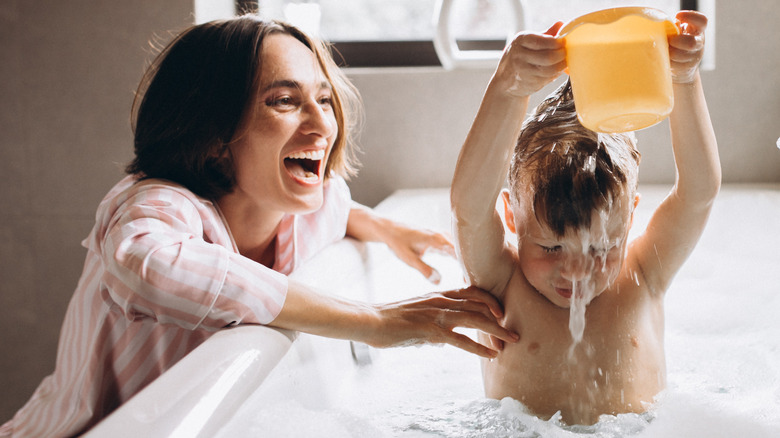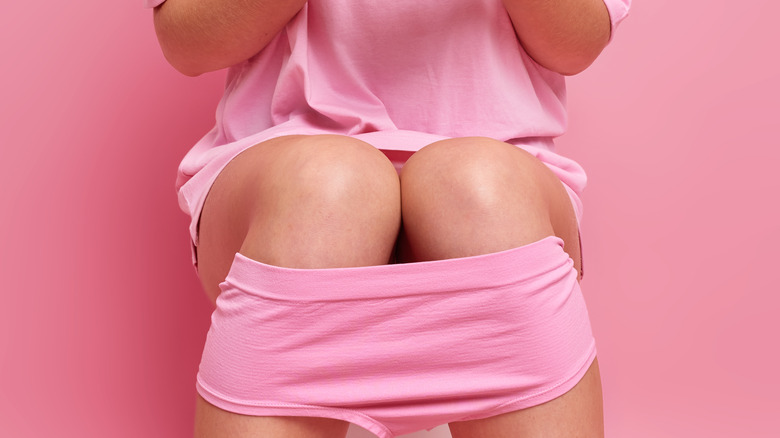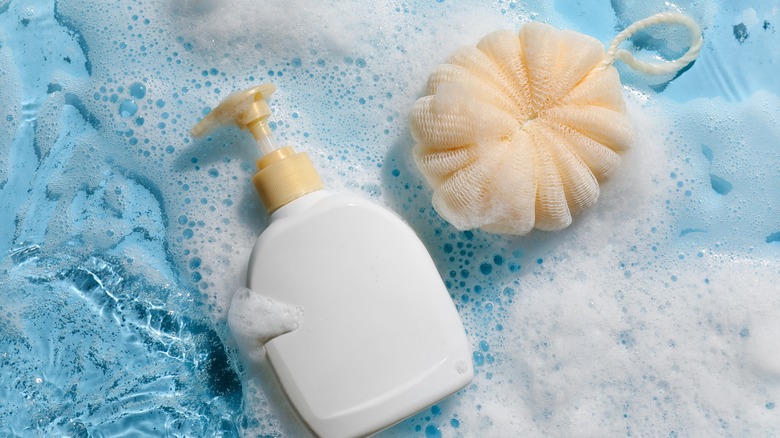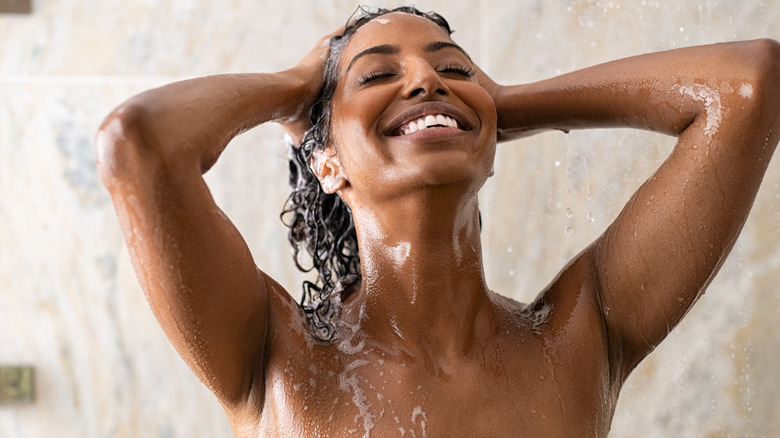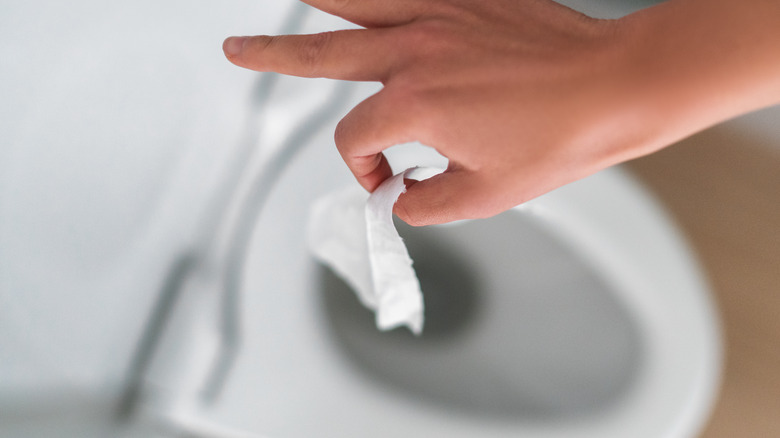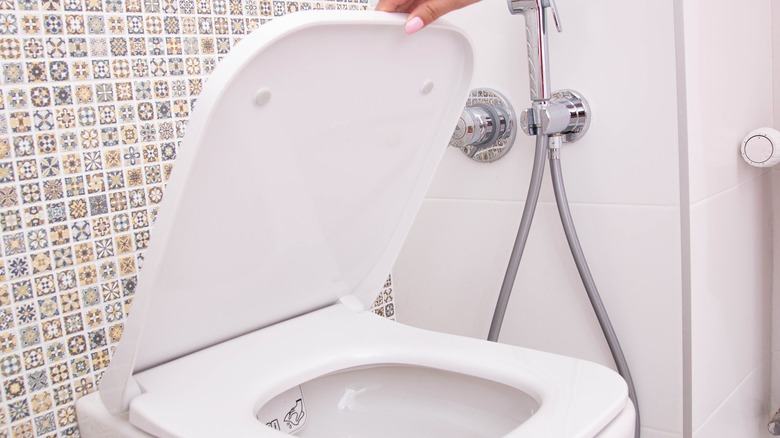Mistakes You May Not Know You're Making In The Bathroom
The invention of the bathroom was no doubt a watershed moment in human history. Not only is it a place to relieve yourself when nature calls, but it's also a safe spot of solitude where you prepare for and unwind after a busy day. Business Insider even suggests job applicants use the restroom during an interview to gain a more insightful peek into a company's culture and how much attention it pays to details. In many parts of the world, tech-savvy people are using smart bidets built into their toilet seats to cleanse their rear ends lightning fast. In fact, Stanford radiology professor Sanjiv Gambhir and his lab are even developing a toilet that analyzes the user's urine and feces to monitor for signs of abnormalities (per Stanford Medicine).
As technology advances, more people are splurging megabucks to elevate their bathroom experience. But what's the point of having a squeaky clean bathroom with state-of-the-art technology if you're not using it right? If you think that going to the loo and cleaning yourself are the most natural and thoughtless activities to go about, chances are you've been the victim of numerous traps and pitfalls of your toileting routine without knowing. From wiping methods to showering habits, we are here to debunk the false assumptions many of you have when it comes to using the bathroom.
Wiping from back to front
One of the most common mistakes people make when toileting is to wipe from back to front. The right technique is to wipe in the opposite direction. "Always wipe from front to back," says ob-gyn Dr. Alyssa Dweck (via Shape). The reason why you should wipe in this direction is to move waste products away from more delicate body parts like the urethra. Wiping from back to front can transmit bacteria from the rectum towards the urethra, heightening the risk of a urinary tract infection or genital discomfort. Therefore, wiping correctly can enhance your toilet experience and improve your overall health.
Another thing to keep in mind is to pat your bottom gently instead of rubbing against it as if you were scrubbing grime off a floor. Using excessive force to wipe yourself can cause microtears in the wiped area, allowing bacteria to creep in and causing an infection, Cottonelle cautions. For optimal cleanliness, some good pressure from a bidet can both clean and refresh your bottom after a bowel movement.
Polishing your anus with soap
A staple of any hygiene kit, a refreshing body wash is effective in removing dirt and excess oil from the skin with a hint of fresh fragrance. However, soap is not meant to be used on just any part of your body, especially the anus. As the opening of the rectum, the anus actually has self-cleaning functions and should be treated with much care, Los Angeles Colon & Rectal advises. Therefore, scented soaps containing additives and cleansers with harsh chemicals, combined with vigorous wiping or rubbing, might cause abrasion and irritation. If you have hemorrhoids, washing the affected area with soap might aggravate your symptoms. According to Healthdirect Australia, using soap for the anal area will lessen the natural oils needed to protect the anus, making it dry and itchy. To clean the anus, use a soap-free cleanser or cream, or just wash it with water every day.
Enjoying a shower for way too long
Nothing beats a refreshing body rinse in a cooling shower or a hot bathtub, letting the water massage your skin and relax your muscles. The recommended maximum shower time, per dermatologist Dr. Edidiong Kaminska (via Healthline), is about five to 10 minutes. This window of time allows for thorough cleansing and hydration of the skin. According to dermatologists Dr. Jessica Krant and Dr. Lauren Ploch (via Today), the shorter the shower, the better. Ploch adds that patients with very dry skin should keep their shower time to "five minutes or less." Overshowering can cause the skin to get dry, itchy, and flaky. Besides, a daily shower is not for everyone. Healthline notes that if you exercise on a daily basis or spend long hours working outdoors, you can hit the showers to rinse dirt and sweat off your body, but keep your bath time short. For those with dry skin, showering two to three times a week is sufficient to maintain good hygiene (via Today).
Throwing wet wipes down the toilet
From keeping babies' butts fresh to dusting furniture to degreasing pots and pans, disposable wet pipes never fail to come in handy in all sorts of situations. Perhaps because they are too serviceable, many people tend to forget that wet pipes are not toilet paper — meaning they shouldn't be flushed down the toilet. Compared to toilet papers that break down into tiny pieces after being flushed down, some wet wipes can't disintegrate in the water, Insider warns. Unsafe for sewers and septic systems, disposable wet wipes can get stuck in plumbing pipes and result in clogging, affecting the sewer system of the entire community. Just because the packaging on baby wipes claims to be "flushable" or "septic safe" doesn't mean they are safe to flush down a toilet. According to Lentz Wastewater Management, other substances and toiletries that don't belong in the lavatory include grease and fat, tampons, cotton swabs, paper towels, and kitty litter.
Not closing the lid when you flush
When you flush the toilet with the lid wide open, tiny aerosolized droplets of water from the swirling bowl that are invisible to the naked eye spout into the air. These aerosols may be infected with fecal germs like E. coli and persist in your bathroom for hours, causing potential damage to your health. Worse, if your toothbrushes sit nearby and are not covered, they can be splashed with fecal matter and covered in a myriad of germs, says Miryam Wahrman, author of "The Hand Book: Surviving in a Germ-Filled World" (via USA Today). In other words, flushing the toilet may sound like a disease-ridden activity, but flushing it with the lid up is akin to an invitation to disease. According to the Microbiology Society, flushing with the lid down can cut the number of airborne particulates by as much as 50%. If you want to keep germs at bay, close the lid before you flush.
Bathrooms are an essential part of the healthy development of humans. How we use the bathroom, from processing our biological functions to using bathroom items for our needs, plays a big part in maintaining good hygiene and preventing germs from attacking our health. The aforementioned mistakes might seem inconsequential, but they all have a far-reaching impact on the sanitation of your bathroom as well as your health.
